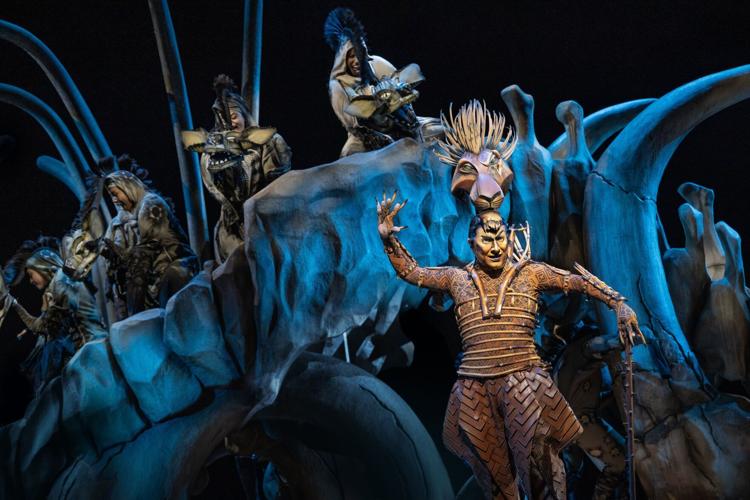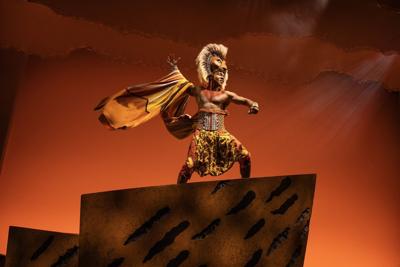“The Lion King” is the most anti-Disney stage musical that Disney has ever produced. And that’s why it’s so successful.
Even more than two decades after director Julie Taymor‘s juggernaut production premiered on Broadway, where it continues to run today, the musical feels like a repudiation of the Disney brand.
Especially in recent years, the entertainment giant has been stuck in a rut. Its products both on the stage and screen seem to increasingly favour quantity over quality. Original content has largely been pushed aside for uninspired remakes and sequels that cash in on pre-existing titles. Creativity has given way to pandering.Â
“The Lion King,” however, which roared back to life Sunday at the Princess of Wales Theatre in a new Canadian production, offers a glimpse not only of what Disney once was, but also of what it could be — a show derived from nothing except the timeless theatrical impulse to stimulate the imagination.Â
While the musical is based on the animated film of the same name, this production strikes out on its own path. In the opening seconds of “Circle of Life,” as a shamanistic mandrill named Rafiki (an exceptionally powerful Zama Magudulela) appears onstage and offers a call that rouses the animals of the African Pride Lands, Taymor establishes the framework of her breathtaking artistic vision.Â

Zama Magudulela as Rafiki in “The Lion King.”
Matthew Murphy DisneyThe sun that rises in the background is a circle made of nothing more than silk and aluminum ribs, wafting in the air as it’s lifted by wires. The menagerie of animals that parades down the aisles is brought to life by more than two dozen performers. Actors in stilts symbolize towering giraffes; women, dressed in white robes, proceed through the theatre with bird puppets in their hands and on their heads; a lithe cheetah, rolling its head from side to side, springs onto the stage.Â
There’s an analogue simplicity to this scene. Taymor and set designer Richard Hudson don’t clobber us with a heavy-handed visual palette. There are no pyrotechnics, no digital projections, no overwhelming costumes that hide the performers.
Instead, their non-naturalistic designs prompt viewers to lean into their imaginations, filling in the details with the suggestive markers that are provided.Â
Taymor, who also designed the costumes, draws from a wide range of global theatrical traditions: Balinese shadow puppetry, bunraku puppetry from Japan (in which the puppeteers are in full view of the audience) and carved wooden masks inspired by those from West Africa.Â
The music, too, is a melting pot of genres. Among the highlights are the rousing South African choral chants composed by Lebo M., supplementing the rather insipid pop-rock score by Elton John and Tim Rice.Â
There’s a good reason why Taymor and her team have chosen to pull from such diverse sources. Though “The Lion King” is firmly set in sub-Saharan Africa, with its array of grassland animals, the musical’s story is universal, transcending time and place.Â

Salvatore Antonio as Scar in “The Lion King.”
Matthew Murphy DisneyIts narrative, drawn up by Roger Allers and Irene Mecchi, is almost mythic: Simba, a young lion and prince to the throne, is exiled from the Pride Lands after his jealous uncle, Scar (a sleazy Salvatore Antonio, completely transformed in makeup almost like a panto villain), murders the cub’s father, Mufasa (David D’Lancy Wilson, in a performance filled with gravitas).Â
Out in the wilderness, Simba is practically adopted by Timon the meerkat (Brian Sills) and a warthog named Pumbaa (Trevor Patt). But after hakuna matata-ing away his childhood, Simba is then forced to reckon with his past, who he really is and his responsibilities as the rightful heir to the throne.Â

Erick D. Patrick as Simba in “The Lion King.”
Matthew Murphy DisneyThe playwrights don’t shy away from these difficult themes. In fact, the musical’s most stirring number, “He Lives in You,” choreographed by Garth Fagan with galvanizing force, confronts those ideas head on, with Simba, now a young adult, coming face to face with his father’s spirit. Anyone who’s lost a loved one is bound to be deeply moved by this sequence.Â
Occasionally, Allers and Mecchi’s “Hamlet”-inspired narrative veers wayward into the territory of camp. The recurring flatulence gag between Timon and Pumbaa feels overindulgent by the fifth time it’s repeated, and the first act still seems to drag, padded with too many unnecessary scenes. (That’s despite the creative team cutting a song from productions of “The Lion King” in 2010.)Â
Thankfully, however, Taymor’s directorial vision never wavers, outdoing itself scene after scene. But it’s never a spectacle for spectacle’s sake. The magic of this production rests in that the spectacle is always meant to serve the story.Â
Taymor is bolstered by a cast, largely comprised of Canadian performers, that’s fully up to the task. Ira Nabong (sharing the role with Lucien Duncan-Reid and Oliver Woon at certain performances) wondrously projects young Simba’s confidence and naive curiosity. As his adult counterpart, Erick D. Patrick possesses a shimmering, agile voice, completely winning over the audience with his tender performance.Â
Meanwhile, as Simba’s friend and love interest Nala, Camille Eanga-Selenge underscores her character’s headstrong personality, even if her vocal performance felt somewhat less secure on opening night. (Nendia Lewars plays her younger counterpart with gusto, sharing the role with Zora Cameron and Ana Victoria Dinapo.)Â
If Simba and Nala lend the musical its heart, then Timon and Pumbaa offer the laughs — and both Sills and Patt land the humour (fart jokes and all) with flair. Rounding out the main cast are scene-stealers Jewelle Blackman, Joema Frith and Simon Gallant, as a trio of bumbling hyenas recruited by the evil Scar. They’re joined by a multi-tasking Will Jeffs as Zazu, a hornbill who serves as the king’s majordomo.Â
As a complete product, no other Disney musical has come close to this iconic production. And it’s hard to envision a world where another Disney show will eclipse this level of theatrical excellence.

David D’Lancy Wilson as Mufasa in “The Lion King.”
Matthew Murphy Disney“The Lion King” was born out of era of risk-taking, dubbed by some the Disney Renaissance. Taymor, for whom the commercial theatre scene was unfamiliar territory, was a bold pick to helm the musical. But she proved transformative, drawing upon her time in the non-commercial and indie sector, where a director cannot hide behind big-budget sets and production designs.Â
In our hyper-commercial theatre landscape today, where it feels like risk-taking is shunned instead of embraced, I’m not sure such a daring production could come to fruition. I hope to be proven wrong.Â
But in the meantime, at least we still have Taymor’s production to savour. And it’s all the better that a whole new generation of audiences will get to experience its beauty: the beauty of the circle of life and the sheer beauty that is the theatre.Â





































To join the conversation set a first and last name in your user profile.
Sign in or register for free to join the Conversation